This weekend the Fungus Federation of Santa Cruz sponsored the 37th annual Fungus Fair. We missed the Fair last year, not realizing there actually was one in Santa Cruz. However, we were determined to attend this year!
We didn’t really start to appreciate the extraordinary variety of fungus that grows on the property during the winter months until last year when we started our Mushroom Monday posts. One of the greatest challenges though is trying to identify each species we encounter. We hoped the Fungus Fair might at least help us to familiarize ourselves with some of the more common species here.
On the way to the fair, as I had my camera in hand, I made Mr. Curbstone stop along the road near an enormous fungus that I’d been watching as I drove by the past week or so. It’s not in the most convenient place to pull over, but there wasn’t much traffic, so we stopped just long enough to take a few photos.
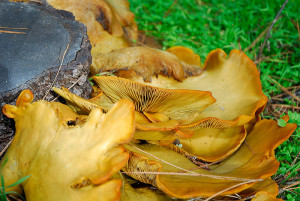
I could see it was a gilled species, and hoped a few photographs would help to reveal its identity at the fair
This huge fungus was growing on an old decaying stump. The stump was approximately 18 inches in diameter, and the fungus was larger than almost any other that I’ve seen. I had no idea what it was, but figured the Fungus Fair might be the place to find out.
When we arrived at the Fair we were amazed at the crowds. We had no idea there were so many local fungophiles!
The main exhibit hall had numerous baskets filled with various fungi from many genera, each labeled with their description, growth habits, and edibility.
We were in mycological heaven!
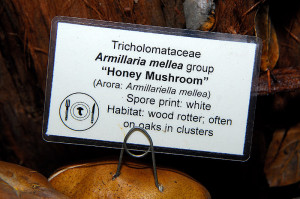
Honey mushrooms are edible, but they're not the only brown clumping fungi in this part of California
Perhaps the most recognizable species, I personally have yet to see a fly agaric in person, but there were numerous examples of reasonably fresh specimens to be seen at the Fair.
There were some other species of fungus we recognized too, as we’ve seen them growing here, like some of the Ramaria species, and the Elfin Saddle mushrooms.
As we turned around the corner of one exhibit, there it was! An example of the fungus I’d just photographed along the roadside!
It turned out to be the common Jack-O-Lantern fungus (Omphalotus olivascens). I chatted with some of the fungus experts on hand, who were impressed that the specimen I’d photographed was so large, and yet undisturbed in public view. Probably a good thing nobody has messed with it…it’s poisonous!
Despite its toxicity, it turns out that the fruiting bodies of this species are bio-luminescent! They glow in the dark! I’m sorry I didn’t take a sample now, but next time I find one of these, I’ll have to see them glow in the dark for myself.
Throughout the fair was this eye-catching poster, an excellent reminder to leave the mushroom hunting to the experts…
In other words…don’t eat the Death Caps! As beautiful as these mushrooms are, they are the number one cause of fatal mushroom poisonings worldwide…
There were experts on hand to help identify mystery mushrooms, and I wish we’d known, as there are a few mysteries growing here at the moment. However, to help improve our own fungus identification skills we became members of the Fungus Federation of Santa Cruz at the fair. As members we can participate in local organized fungus forays, attend the monthly meetings, and learn from others more well versed in the world of fungus identification than ourselves.
In addition to all the fresh fungi, there were lectures, and cooking demonstrations from local chefs. Numerous vendors were also on hand selling everything from mushroom identification books and magazines, to grow-your-own culinary mushroom kits, and coffee mugs with lids resembling your favorite fungus of choice.
If you didn’t make it to the Fair this year, this video filmed by Ken Goldstein last year gives you a good idea of what you missed!
If like us, you’re fascinated with fungi, but want to learn more about the species growing in your area, contact your local mycological society, group, or club.
For a list of societies in the United States, see here. Many offer classes in edible mushroom identification, and organize mushroom hunting trips in your region. You can also enquire as to whether your local mushroom hunting group puts on a fair similar to the one here this last weekend. While the gardens are quiet in winter, it’s a fabulous way to have fun with fungus instead!
————-
For more information about Bay Area Mushrooms see:
North American Mycological Association
Bay Area Mycological Society
Fungus Federation of Santa Cruz
Mycological Society of San Francisco
Sonoma County Mycological Association

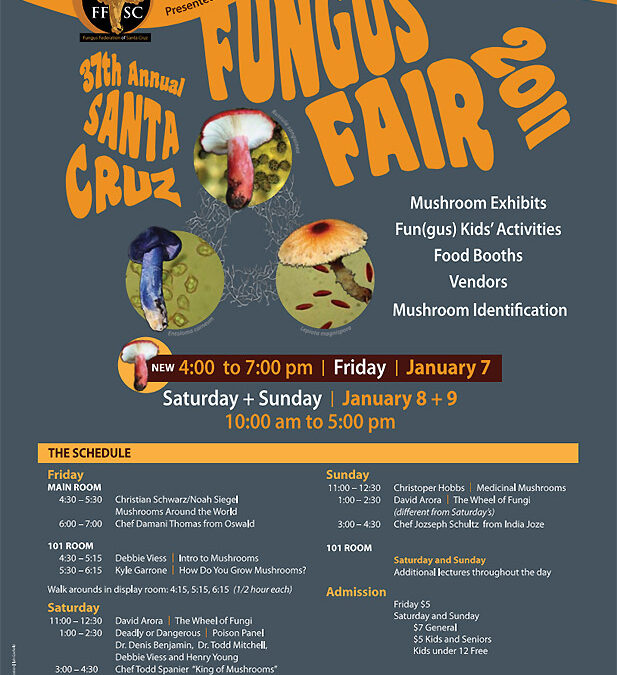
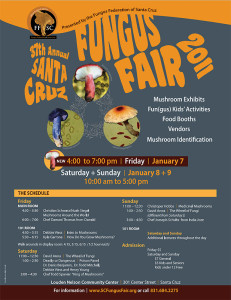
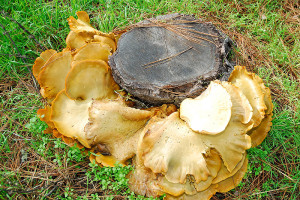

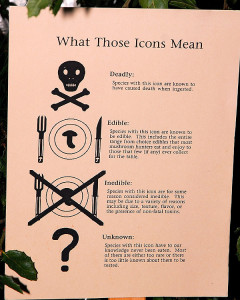
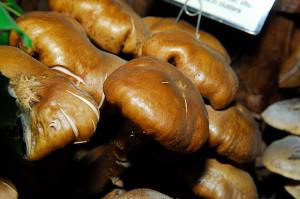
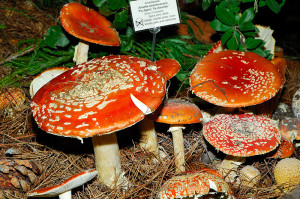
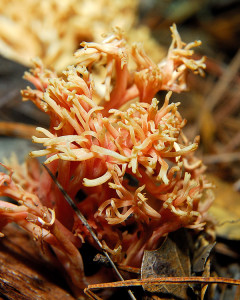
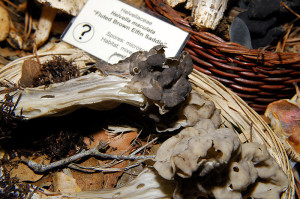

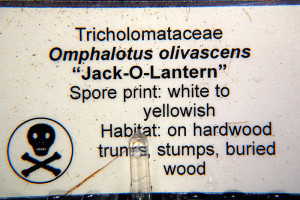
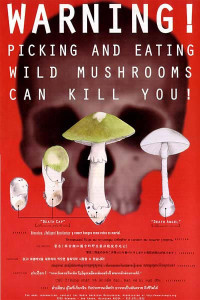
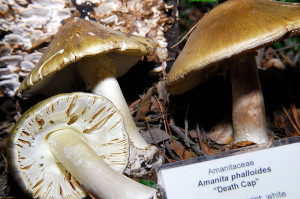
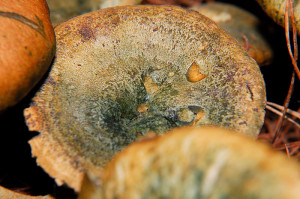
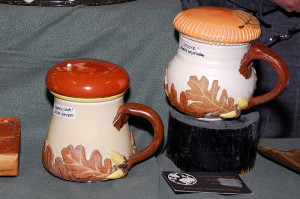
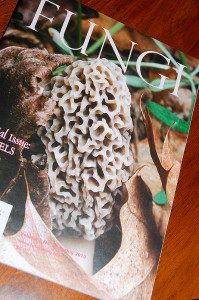
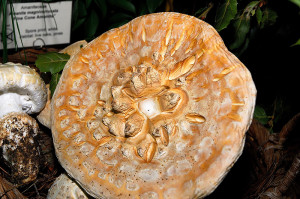







A new group is getting underway on the peninsula,
Mycological Society for the San Francisco Peninsula and South Bay
A new mushroom club for the San Francisco Bay Area serving residents of San Mateo and Santa Clara counties. Founded in 2009, we meet the first Tuesday at the Redwood City Main Library, 7 to 9 pm. Visitors are welcome.
No website yet, but there is a yahoo group for it – penmc
Incidentally, I believe the red Warning! chart was initially developed some time ago, after a large number of immigrants arrived from southeast Asia at the end of the Vietnam war. There were apparently a number of unfortunate incidents due to the resemblance of death caps to tasty, harmless mushrooms from their native lands.
Thanks Anne, that’s good know! Redwood City isn’t so far from here.
Interesting about the poster, that actually makes a lot of sense. Still good words to live by today though, even for us local types!
Of the crafty items offered for sale at the Fungus Fair this year, the silk scarves and skeins of hand spun yarns were my favorite! They had been dyed using mushrooms, producing a variety of breathtaking earthy soft colors ranging from warm taupe to muted yellow ochre…
I saw the silks, and the scarves, they were beautiful. If I was more artsy inclined, I think dying fabrics with mushroom pigments would be a hoot. Heck, even not being terribly artistic, I still think it would be a hoot!
I wish I had actually been at the fair, but I am glad I was there virtually with you. Thanks so much for the list of societies—I am going to contact mine.
Please do Carolyn. If you even have an inkling of wanting to know that a species is beyond ‘oh, gee, a mushroom’, I think these groups are fun. I have no intention of foraging mushrooms for food, but my ‘need-to-know’ brain would still like to know what it’s looking at! 😉
I have almost no knowledge of mushrooms, but there sure are a lot of really interesting looking ones. Sounds like the fair was a lot of fun(gi) 🙂
LOL, it was a lot of fun! For one, I had no idea how many species there are locally. Fungi have very specific requirements for growth. We have some oak, some fir, but we don’t necessarily have all the needs for some species to grow here. These fairs help you to appreciate how specific the needs are for some species to grow, and also teach you what species you should look out for…and most importantly…when!
I too am a fan of ‘the fungus among us’! Fun to catch up after crazy/stressful holidays. As always, a joy to visit, dear Clare. Do hope the New Year is amazingly wondrous!
Thanks Joey, the New Year is thus far…busy…but great! Do you have any fungi among ye?
Damn I missed it!
I’m fairly certain I uttered those exact words last year!!! I was so PO’ed I’d missed it. I tend to think our rainy season is perhaps later than it really is, perhaps because I live uphill of most Santa Cruzans. Regardless, I was surprised last year that the fungus fair was so early. I don’t think I found chanterelles or elfin saddles until after February last year. Well, pencil it in for next year. I’m not sure you’d need to go more than once every few years, but it was a fun experience!
I am not one for picking them or even identifying them, but do love the beauty of form and color. The Fly Agaric and Coral fungus are really quite beautiful. Some family members pick mushrooms to eat, but I was never willing to partake. I know I should at least learn to identify our local fare.
Hello Clare
That’s great that you have now joined a society – I’ve always wanted to go on a fungi foray.
I am just amazed by fungi – I love taking photographs of them but most of them in my photo archives they are unnamed.
I saw an agaric one for the first time last autumn while out walking and since then someone has told me that our bluebell wood is full of agarics in October.
We just have a few fungi out at this time of year – our main fruiting season is October here in Scotland.
What a fantastic resource! I’m jealous. I had to look closely at the fly agaric sign to see if they’re edible (they’re not) as I see these mushrooms regularly here in fall.
I’m jealous! I’ve never seen one in person, well, except at the Fair 😉
OOooh… so so so jealous! How fun! I was surprised your mystery stump mushroom turned out to be a Jack-o-lantern, I always hear they are easy to mistake for chanterelles. Those don’t look chanterelle-y to me, but fungus can be variable so maybe it has versions that are more akin than others.
I think I’ll be harassing the mushroom people I know to get a festival going for our region!
Honestly, the Jack-O-Lantern doesn’t look terribly chanterelle-like to me either. It does have a similar coloration to our golden chanterelle, so I could see how a very inexperienced mushroom hunter could confuse it. However, the Jacks have true gills which is a dead giveaway, and I don’t tend to find my chanterelles growing on stumps! 😛
Looks like you guys had a lot of fun! Love all this information. It’s great to have your website as a resource when I see some oddball fungus in my garden or out in the swamp.
Glad to have been to the fair through you. There were some great looking fungi at the fair. I don’t know of anything like that in my area but then I never checked.
Thanks for stopping by Patty. It’s been quite interesting to discover the whole winter world of fungi the last couple of years. I was shocked at how many people attended the Fair. If you do find one in your area, it would be interesting to go, if only to see what grows in your region.
I had no idea there was such a thing as a fungus fair! Quite interesting, too. I’ve never made an effort to identify the ones that pop up around here, but once in a while a strange alien thing will make me wonder. Thanks for all the great info you put out about mushrooms, as well as many other topics!
Clare, considering my mishaps in the kitchen, I allow myself only one mushroom to pick and one type only, the Chanterelle.
As usual your post was fascinating and entertaining, thanks!
I agree with you Tom. Even with my ‘improved’ knowledge the last year or so, I still just hunt them with a camera lens. I buy the mushrooms I eat, although I was tempted to try our golden chanterelles and black trumpets that were growing here last year. I just don’t ever want to make that fatal mistake 😉
Oh wowie wow wow! The Jack-O-Lantern mushroom is one I’ve always hoped to see.
I’ve seen Amanita muscaria in the Oakland hills from time to time.
I totally spaced out and missed the Fungus Fair at the Oakland Museum this year. I took two classes the year before, one on dyeing from mushrooms, and one on dying from mushrooms.
http://howsrobb.blogspot.com/2008/12/dying-from-mushrooms-and-dyeing-from.html
Very, very cool.
It sounds like you had a great time. I don’t suppose picking mushrooms can be entirely safe but the more ecperience you acquire the better. Seeing them in the flesh must help too. It all looks fascinating.